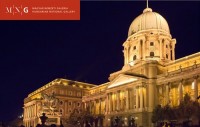Emese, the mother of Prince Álmos, was impregnated in her sleep by the totem of the Árpáds, the Turul bird. The story was related by Anonymus, a late twelfth century chronicler. The subject was taken up as Hungary’s national Romanticism emerged, and gained wider currency during the preparations for the millennial celebrations (1896), and in the Horthy era (1920–1944). With the lack of iconographic precedents, the period of historicism made use of the depictions of the somewhat similar story of Leda and the swan, which made the scene unjustifiably sensual: Emese is seen naked, with the beak of the Turul touching her lips.Fülöp Beck Ö. also represented the ancestress of the House of Árpád without clothes, but there is a less intimate relationship between the two figures. The bird at the feet of the female figure is static, not animated, which puts emphasis on the symbolic meaning of the scene. In a sense, the composition is reminiscent of medieval funerary monuments, which often included the heraldic beast (i.e. totem) of the deceased.
en

